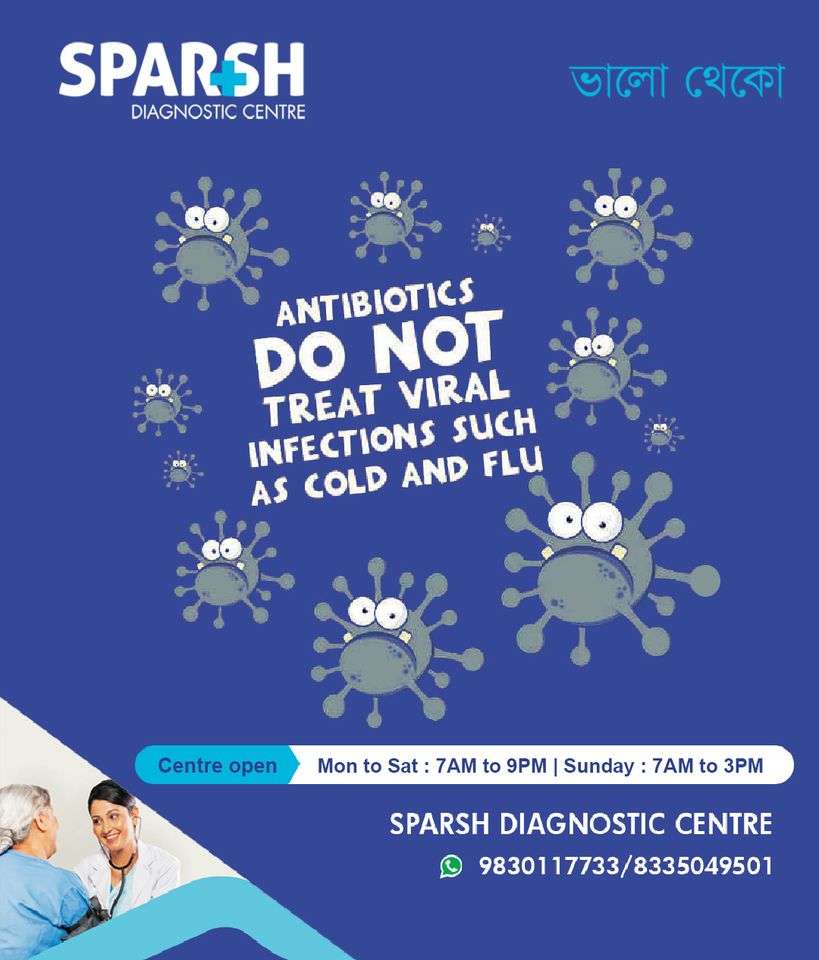Antibiotics have revolutionized modern medicine by effectively combating bacterial infections. However, a major misconception persists: that antibiotics can treat viral infections. At Sparsh Diagnostic Centre, we believe in empowering patients with knowledge to make informed health decisions. This comprehensive guide dives into the truth about antibiotics and viral infections—what works, what doesn’t, and why it matters.
1. What Are Antibiotics?
Antibiotics are medications specifically developed to target bacteria, either by killing them (bactericidal) or inhibiting their growth (bacteriostatic). Since bacteria differ fundamentally from viruses, antibiotics are ineffective against viral infections, such as colds, flu, and COVID‑19.
Why Antibiotics Don’t Work on Viruses
Viruses replicate inside human cells, lacking the structures (e.g., cell wall) that antibiotics target.
Using antibiotics when they’re not needed doesn’t speed recovery, and may lead to side effects like gut disturbances.
Misuse increases the risk of antibiotic resistance, which threatens public health.
2. Common Misbeliefs & Health Risks
Myth 1: “Antibiotics cure any infection.”
False. Antibiotics are effective only against bacterial infections. Viral illnesses require other forms of support like rest, hydration, and symptom relief.
Myth 2: “It can’t hurt to try antibiotics.”
Incorrect. Unnecessary antibiotics can cause side effects and accelerate the emergence of drug-resistant bacteria, often called “superbugs”.
Myth 3: “Completing half the course is fine.”
Not true. Skipping doses or stopping early encourages bacterial survival and resistance .
3. Why Overuse Stacks Up to Trouble
A. Antibiotic Resistance: A Global Threat
Frequent misuse reduces an antibiotic’s effectiveness. We now face bacteria like MRSA, CRE, and multidrug-resistant tuberculosis.
B. Superbugs & Consequences
MRSA: Resistant skin and wound infections
CRE: Severe, often hospital-acquired, infections
Resistant TB: Challenges in treating tuberculosis
Each case leads to tougher, more expensive treatments and longer recovery.
C. Health & Economic Impacts
According to recent data:
By 2050, 10 million deaths annually could result from resistance, weighing down global GDP.
In hospitals, antibiotics rank among top causes of adverse drug events in the US.
4. Safe Use of Antibiotics
Rule #1: Only for bacterial infections
Common bacterial infections include strep throat and urinary tract infections. Viral illnesses—such as viral fever—should never be treated with antibiotics.
Rule #2: Follow your prescription
Always complete the full course prescribed—even if you feel better early.
Rule #3: No shared or leftover antibiotics
Using someone else’s prescription risks ineffective treatment and unnecessary side effects.
Rule #4: See a healthcare professional
Never self-prescribe antibiotics. A correct diagnosis confirms whether bacteria are the culprit.
5. What to Do Instead If You Have a Virus
| Symptom Relief | Advice |
|---|---|
| Fever, aches, headaches | Take paracetamol or ibuprofen |
| Sore throat | Use throat lozenges or saltwater gargles |
| Cough, congestion | Try humidifiers or decongestants |
| Dehydration | Sip water, herbal tea, or rehydration solutions |
| Rest | Allow your immune system time to fight the virus |
6. Common Conditions That Require vs. Don’t Require Antibiotics
✅ Bacterial Conditions
Strep throat – requires antibiotics to prevent complications
🚫 Viral Conditions
Cold or flu, bronchitis, viral fever, COVID‑19 – no antibiotic required
Examples of Misuse
Prescribing antibiotics for bronchitis, sinusitis, and ear infections (in most cases) can fuel resistant bacteria.
7. Combating Antibiotic Resistance: What We Can All Do
In Healthcare Settings
Proper diagnosis: Distinguish between bacterial and viral infections
Stewardship programs: Reduce unnecessary prescriptions.
Agriculture
Limit antibiotics in livestock farming to essential use only.
Global Cooperation
Shared data on resistance
International guidelines and regulations
Innovation & Research
Invest in new antibiotics, bacteriophage therapy, and rapid diagnostic tools.
8. The Role of Vaccines & Prevention
Vaccines prevent diseases like pneumococcal infections and flu that may otherwise require antibiotics
Preventive measures reduce antibiotic use and slow resistance spread
FAQs About Antibiotics & Viral Infections
Can I use leftover antibiotics?
No. They may not match your condition and could exacerbate resistance or cause illness.Can antibiotics prevent complications from viral infections?
Only if there is a bacterial co-infection. This must be confirmed by a healthcare provider.What if symptoms worsen with a virus?
Persistent high fever, breathing difficulty, or worsening symptoms should prompt immediate medical attention.How to distinguish between a bacterial and viral infection?
Viral infections often involve widespread symptoms without localized pus or specific bacterial signs. Only tests can confirm.What preventive steps help reduce antibiotic use?
Focus on hygiene, vaccination, prompt medical advice, and avoid antibiotic misuse.
Antibiotics are powerful—when used properly. For bacterial infections, they save lives. But they are useless and potentially harmful for viral illnesses.
Use antibiotics responsibly:
Follow doctor’s advice
Never self-prescribe
Never stop treatment early
Raise awareness and build healthier communities
By combining careful antibiotic use with vaccines, hygiene, and diagnostics, we can preserve these vital medicines for future generations. Sparsh Diagnostic Centre is committed to guiding you with the best in healthcare and education.

At Sparsh, we believe in responsible use of antibiotics for optimal health outcomes:
Precise Diagnosis: Targeted testing to differentiate between bacterial and viral infections
Expert Oversight: Guidance from qualified doctors and specialists
Public Education: Clear, reliable information to empower patients
For help or advice, call our helpline at 98301 17733 and 83350 49501.
#BhaloTheko
Disclaimer:
No content on this site, regardless of date, should ever be used as a substitute for direct medical advice from your doctor or other qualified clinician.
![]()






[…] Can antibiotics treat Mono? […]
[…] Certain environmental triggers, such as smoking, nonsteroidal anti-inflammatory drugs (NSAIDs), antibiotics, and high-fat diets, may increase the risk of developing Crohn’s disease or trigger flare-ups in […]
[…] Bacterial Infections: Streptococcus pyogenes, the bacterium that causes strep throat, is a common bacterial cause of a sore throat. Unlike viral infections, strep throat requires antibiotic treatment. […]
[…] They are ineffective against viral infections, such as the common cold or flu, and using them for non-bacterial infections contributes to the problem of antibiotic resistance. They can be classified into two broad […]
[…] used to describe a wide range of fevers caused by viral infections. Unlike bacterial infections, viral infections cannot be treated with antibiotics and usually need to run their course. The body’s immune system fights off the virus, leading […]
Good article
Dear Sir,
Thanks for the kind words of appreciation.
Regards,
Team Sparsh
People should stop taking antibiotics for Viral infections. They do not help. Period!!!
Over use and unregulated use of antibiotics are creating super bugs. We need to be more careful with antibiotic usage.
True!!!
Very informative article
Dear Ma’am,
Thanks for the kind words of appreciation.
Regards,
Team Sparsh